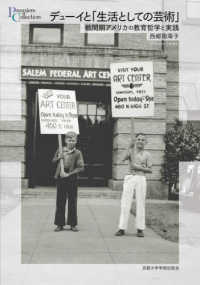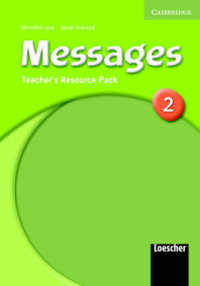- ホーム
- > 洋書
- > 英文書
- > Literary Criticism
Full Description
Introduction to the Attribution of Literature describes the first unbiased and accessible authorship attribution method, and uses it to present the first accurate re-attribution of 311 canonical texts from the 18th century to only 10 ghostwriters, and 323 texts from the 19th century to 11 ghostwriters. For example, the little-known Sir Francis Cowley Burnand is chronologically, stylometrically, and with handwriting analysis proven to be the ghostwriter behind 55 canonical tested texts, including "Emily Bronte's" Wuthering Heights, "Collins'" Woman in White, "Doyle's" Sherlock Holmes, "Kipling's" Captain Courageous, "Stoker's" Dracula, "Anthony Trollope's" American Senator, "Wells'" Island of Doctor Moreau, "Wilde's" Picture of Dorian Gray, and "Dickens'" Great Expectations. This method applies a combination of 23 to 28 different types of punctuation, parts-of-speech, and lexical linguistic tests. Parts of this book offer extensive statistical evidence in support of why this method's findings are quantitatively reliable. If preceding attribution methods had been equally reliable; then, they would have also concluded canonical British texts have been overwhelmingly ghostwritten. A section in this book explains the methodological flaws of these preceding attribution approaches because of which they have incorrectly reaffirmed their canonically-accepted bylines. It includes definitions of central stylometric terminology, and explains how readers can apply the described strategies to their own attribution research at any academic level.
Contents
Introduction
1. A Brief History of the Unmasking of Ghostwriting
2. Experiments in Unmasking
3. Why This Method Is New
Part 1. The New Stylometric Attribution Method
Chapter 1. Anti-Assumptions as a Pre-Requisite for Computational Stylometry
Chapter 2. The Steps of the Recommended Stylometric Attribution Method
Chapter 3. Selecting a Suitable Corpus
Chapter 4. Preparing Texts for Testing
Chapter 5. Reasons for the Use of Free Accessible Software
Chapter 6. Discussion of the Data in the 18th and 19th Century Corpuses
6.1. Summary of the Quantitative Findings with a Review of Statistics Terminology
6.1.1. Correlation Matrixes and Visualizing Dual-Test Outputs
6.1.2. Firm versus Fluid Groups
6.2. Attribution Accuracy Verification by Comparing Stylometric Conclusions Against Bibliographic and Other Categories of Data
6.2.1. Printers, Booksellers and Publishers
6.2.1.1. Bookselling Mysteries of the 18th Century G-Group
6.2.1.2. Other Linguistic Group-to-Bookseller Clusters in the 18th Century
6.2.1.3. Linguistic Group-to-Bookseller Clusters in the 19th Century
6.2.2. The Theater Mono/Duopoly and the One to Two Ghost-Playwriters
6.2.3. Patterns in Byline Types
6.2.4. Group-Exclusive Word Patterns
6.2.5. Group-Exclusive Phrase Patterns
Chapter 7. A Method for the Quantitative Selection of the Most Likely Ghostwriter in a Linguistic-Group
Part 2. Experiments to Explain Weaknesses of Previous Attribution Methods
Chapter 8. Thomas Mendenhall's Visual Curve Word-Length Comparison Model (1887)
Chapter 9. George Udny Yule's Sentence-Length Ranges and Statistics Model (1939)
Chapter 10. George Udny Yule's Vocabulary Model (1944)
Chapter 11. Zhao and Zobel's 634-Text Corpus (2007)
Part 3. Experiments to Verify the New Method's Accessibility and Accuracy
Chapter 12. Statistical Comparison of Standard versus Newly Proposed Stylometric Methodologies
12.1. Data Randomization to Verify the Strength of Statistical Findings
12.2. Proximity of Same-Byline and Same-Group 19th Century Texts
12.3. Correlation or Incongruity Between Publication Dates' Distance and Group Matches in Same-Byline Texts
12.4. Influence of Text Size on Test Output
12.5. The Impact of a Multi-Period and Over-Sized Corpus on Attribution Results
12.6. Influence of the Proximity Cut-Off Percentage on Attribution Decisions
12.7. Verifying the Attribution Method by Applying it to Modern Texts
12.8. Structural-Genres and Linguistic-Signatures: Overlaps and Incongruities








